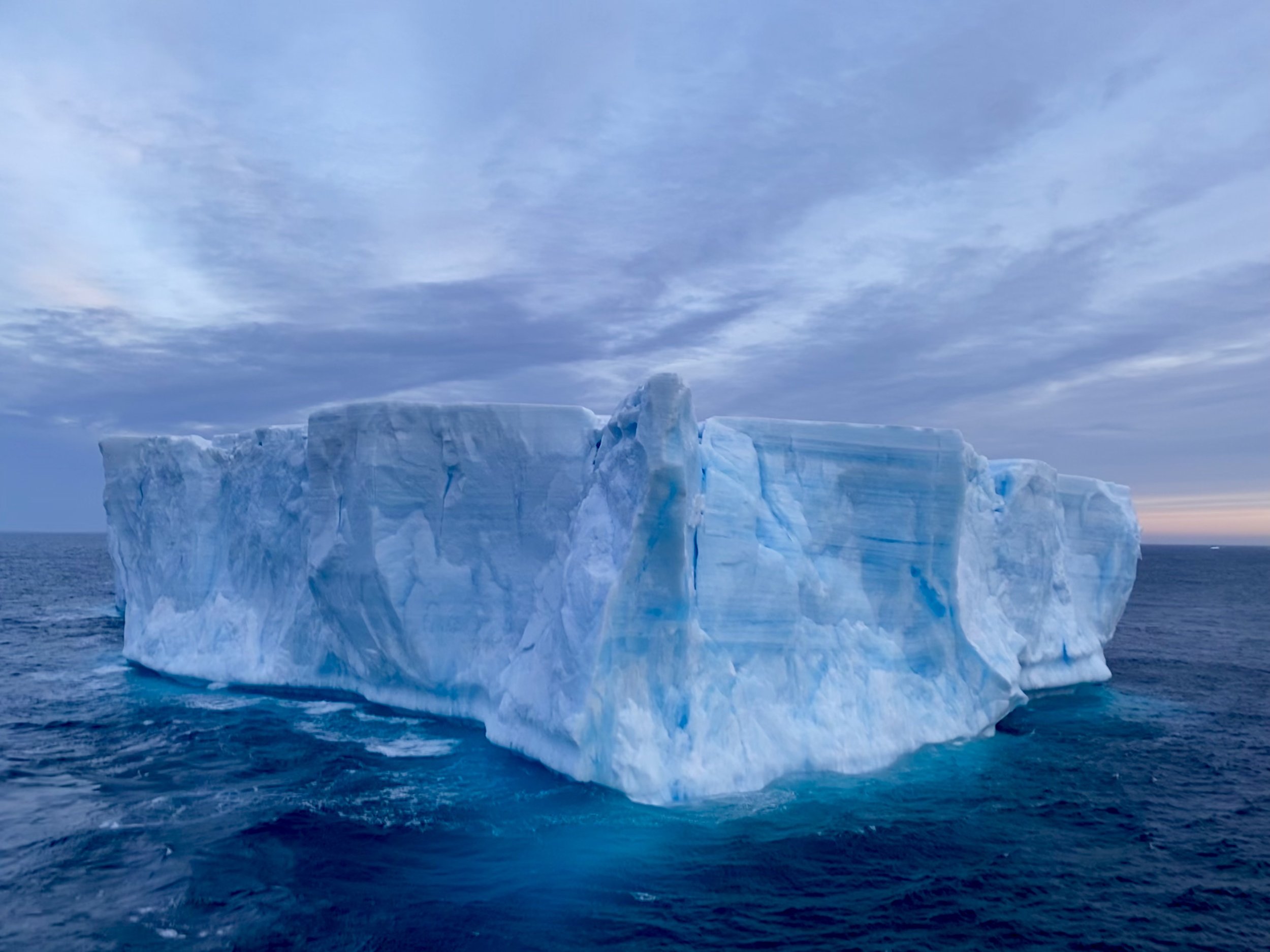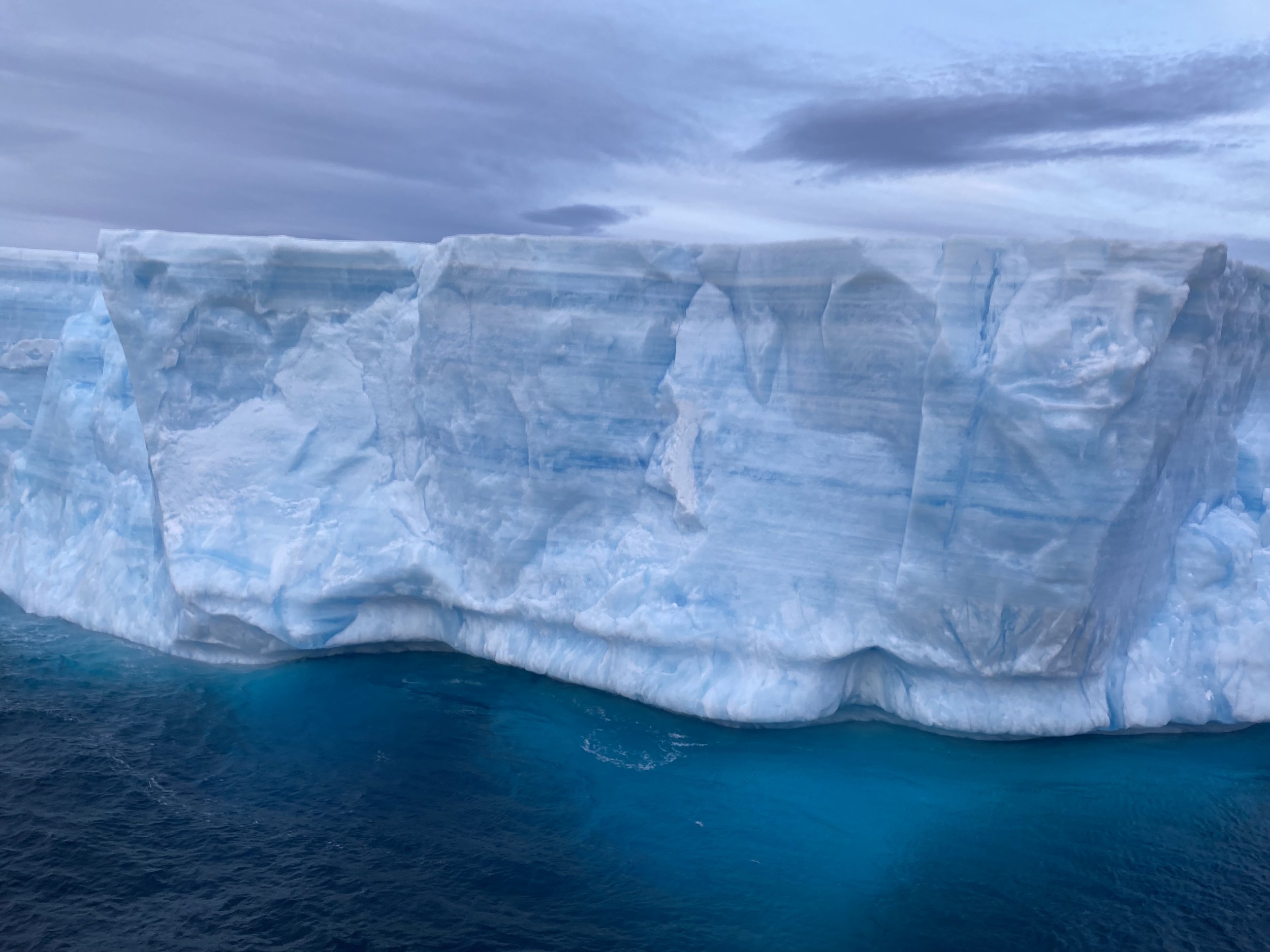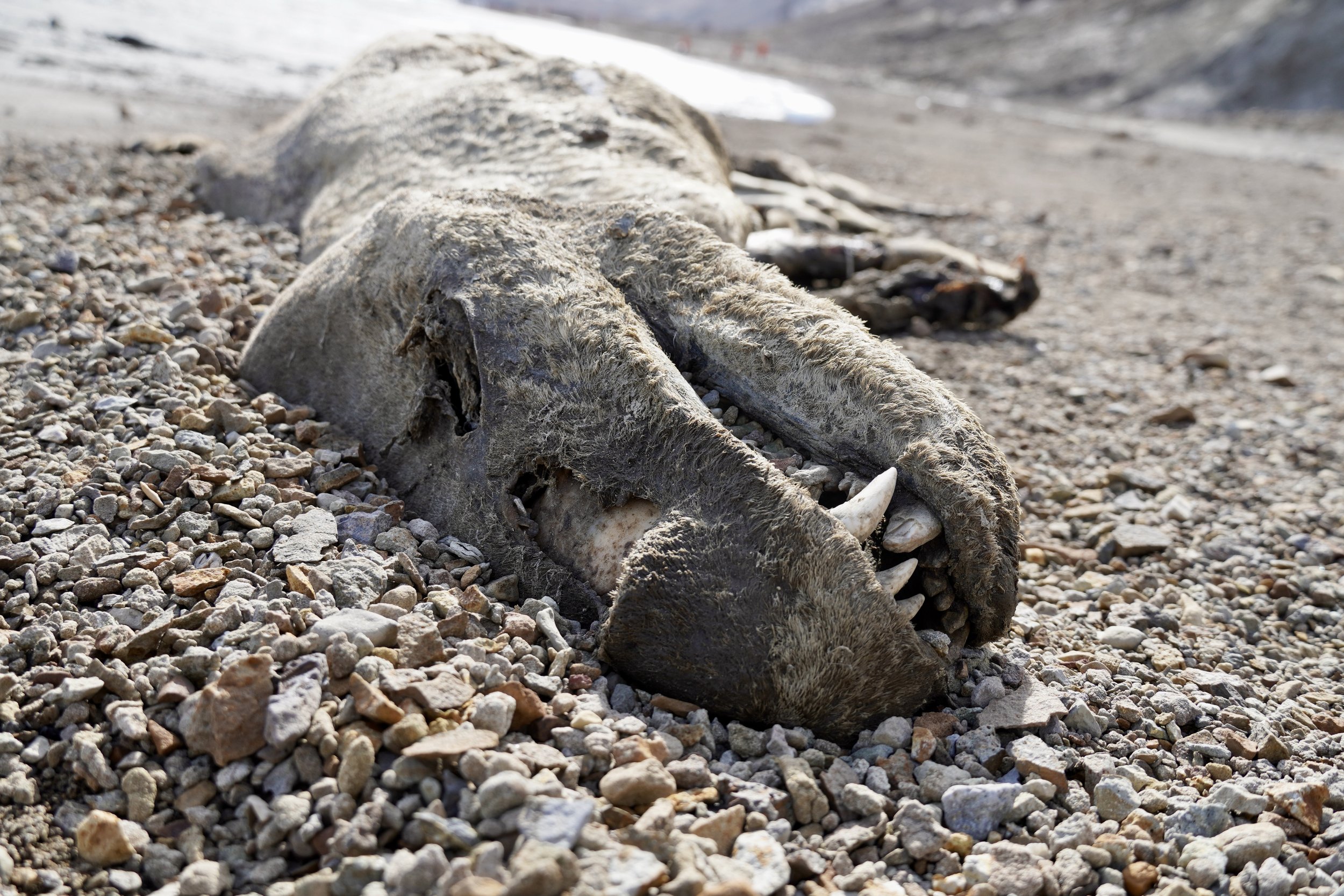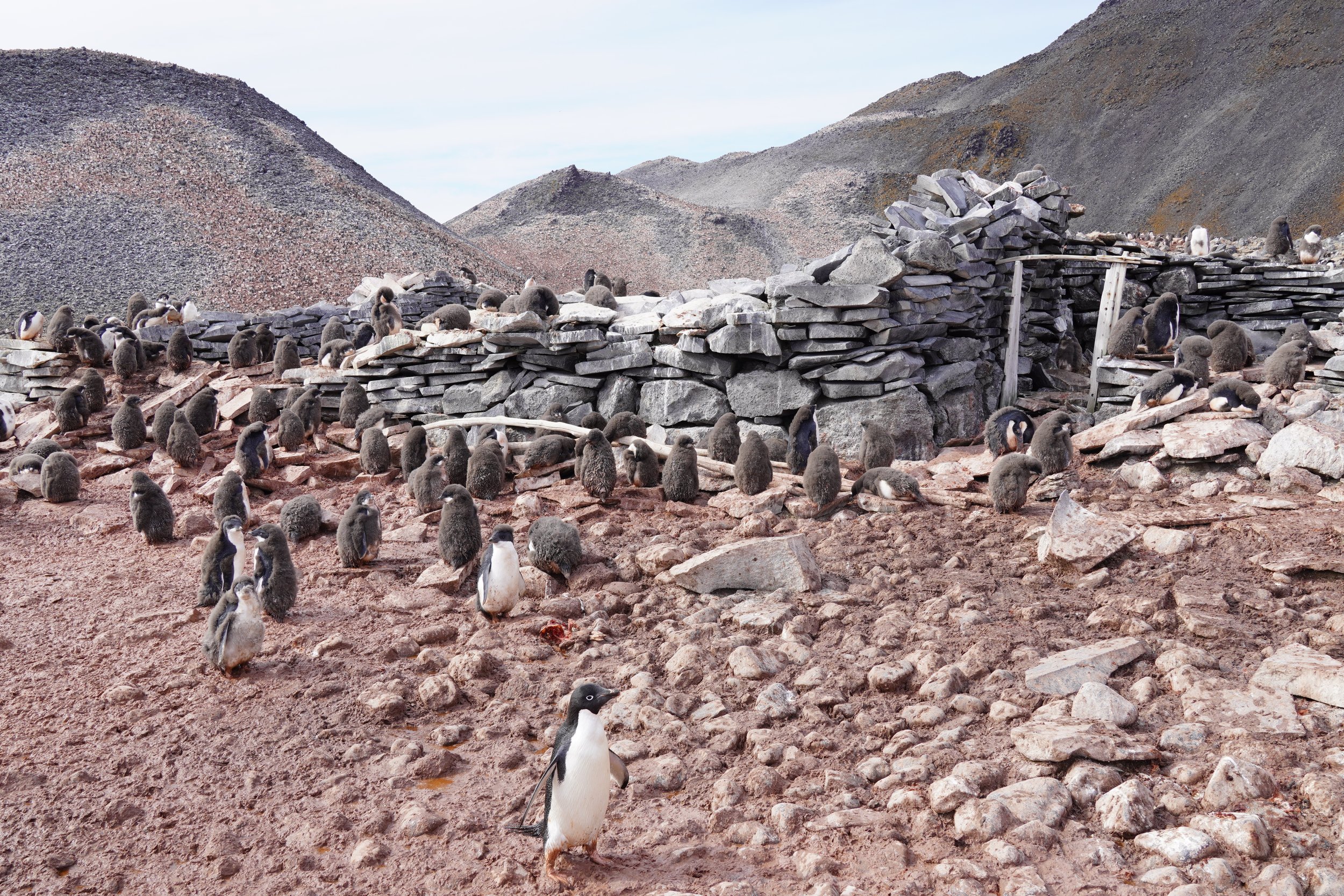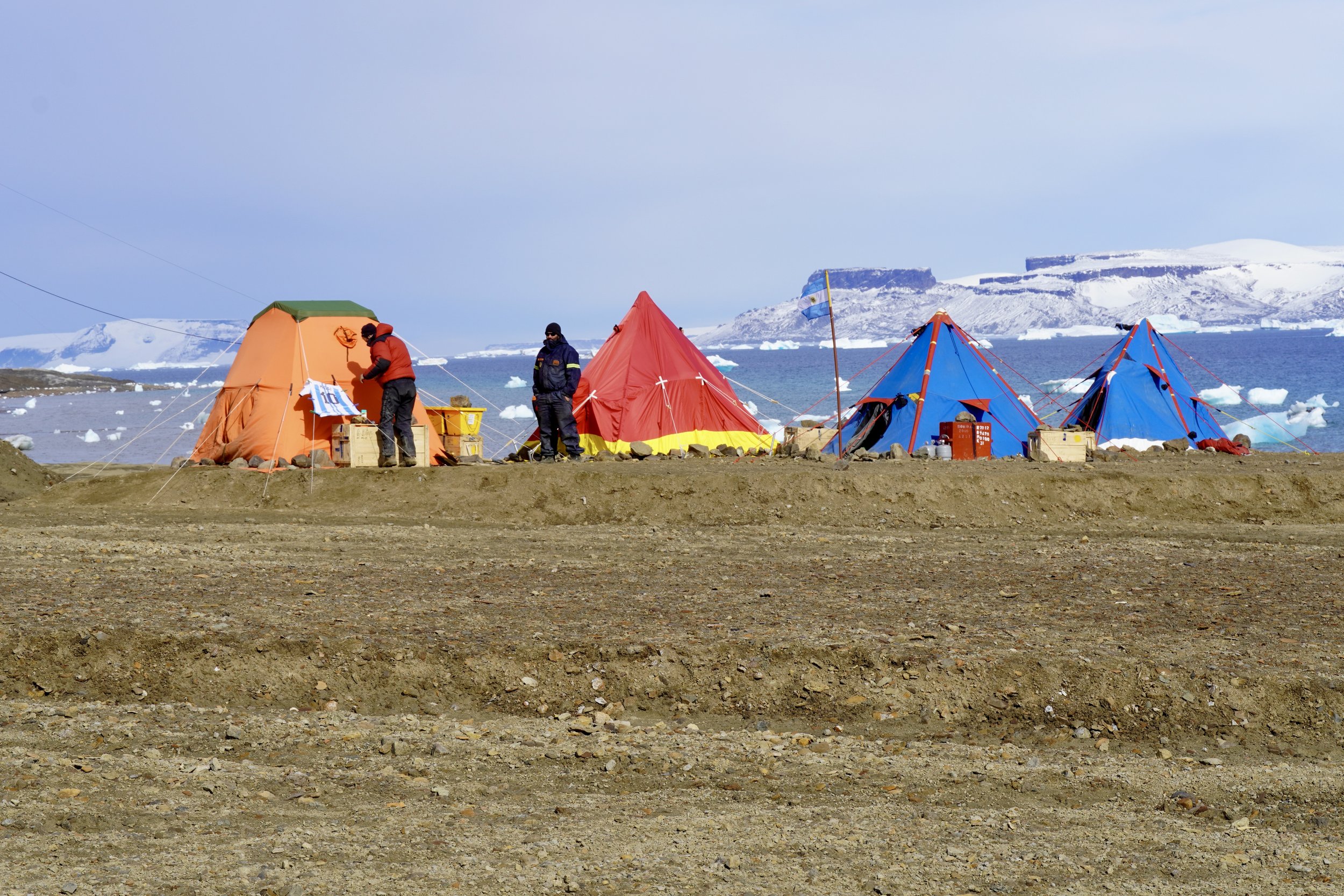Antarctica Part 3: Exploring Explorers
Antarctica has claim to the largest piece of ice on the planet. It reaches a 4.5km depth and is up to a million years old at its thickest point. It is also is Earth’s largest fresh water reserve, containing 60-70% of Earth’s total fresh water (the remainder is made up of lakes, rivers, other glaciers, and underground systems). It’s difficult to comprehend the scope of this, but for comparison, only .3% of Earth’s total fresh water is surface water - that is lakes, rivers, swamps, etc. That means almost all of Earth’s fresh water is either under ground or stored in ice, and the majority of it is in Antarctica’s ice.
Welcome to Antarctica Part 3: maybe I’ll stop telling stories long enough to get past day two.
(In case you missed them, here’s Part 1 and Part 2 ).
We left off aboard the National Geographic Explorer, enroute to Tay Head Island, when Michael Jackson’s voice (our fearless expedition leader) came over the intercom:
“There has been a pod of killer whales spotted at 3 o’clock” (that’s straight off the right or starboard side of the ship). Immediately everyone rushed outside to catch a glimpse of this rare sighting. (Later Will would ask the captain if they can feel the lean of the ship when the entirety of its human capacity inhabits one side - nope).
These are Type 2B killer whales, a smaller killer whale that appears a little more yellow and grey then black and white. This is due to a layer of algae on their back. These killer whales have an interesting spa treatment practice. They will swim very fast and continuous from the cold waters of Antarctica to the warm waters off the coast of Argentina and Uruguay. This will regenerate their skin, the equivalent of humans shedding dead skin cells, and will make their black and white colours appear more vibrant.
Photo credit: Jonny Reid
MJ convinced the captain to alter course and cruise along side the porpoising pod. It was an improbably unique way to enjoy lunch. But as all things end, we eventually said goodbye to our flippered friends and corrected course to Tayhead Island. Here we were sanctioned a sort of choose your own adventure. You could enjoy a short scenic walk along a beach, or take a long hike around the island, exploring a few areas, and ending with a moderate hill climb skirting the edge of a glacier. We chose the longer option.
Back in our cabin, we had to decide what to wear on a 4km hike in Antarctica. The temperatures we experienced in Antarctica ranged from +8 to -6 degrees Celsius (though the winds coming off the ocean made it feel colder, and it was consistently windy). Boarding the zodiacs involved a fully waterproof outer layer and camera equipment in waterproof bags, plus a life jacket. We learned the hard way that sunscreen on the small portion of your exposed face was a must (we both ended up burning the underside of our noses from the glare off the snow). Drinking water was allowed on shore, but no food, and if you had to use the washroom you would be ushered back to the ship and not allowed to return to shore. So it was suggested to take your bathroom breaks accordingly.
Landing #3 - Tay Head Island
Here was our first sighting of fur seals.
These adorable creatures with their cute feline-looking whiskers are actually quite temperamental, and can turn on you quicker than you would expect a seal would be able to move, and that’s because these guys aren’t actually true seals. True seals are more like sausages with flippers. Fur seals are pinnipeds. They have four leg-ish looking flippers that move independently of each other, and they can run up to 24 km/hour. Though this is nowhere near as impressive as their 48 km/hr speeds they are capable of in the water, I guarantee it’s a lot faster than Will or I would be moving in our waterproof rubber boots and -4 degrees Celsius worth of winter layers. IAATO says: stay 15m away at all times.
Not outrunning a fur seal in this garb.
We were divided into small groups and trekked around a rocky beach. Some great photos of the groups were taken on this hike.
You will notice Will and I are the only guests who opted out of the trademark National Geographic bright orange parka. We got questioned about this constantly, to which we answered “we’re Canadian. We don’t need more parkas.” This is true, I own 3 parkas, one of them is even bright orange, none of which I even bothered to take for the balmy Antarctica summer. And I’m glad we made this decision. Looking back at the photos, I find it hilarious as we are so easy to spot.
Photo credit: Jim Pfitzer.
Photo credit: Jim Pfitzer.
Fur seal carcass.
Cheeeeeeeese!
We hiked to a colony of Adelie penguins, who chose a nesting site with a view! This was clearly the nesting site for the “overpaid 1%” penguins.
Here you really get a sense of how close the Skua predators fly to the penguin nests. They literally hover just overhead.
Photo credit: Jim Pfitzer.
Our hiking group lucked out and had both National Geographic photographers along as guides. They were being extra helpful and and offered to take photos for everyone.
Photo courtesy of Susan Seubert.
Photo courtesy of Jim Pfitzer.
We continued to the final segment of the hike, walking along a Glacier.
Where’s Waldo?… I mean Amy and Will.
Photo credit: Jim Pfitzer.
On the return route to the ship we dodged a few more fur seals, then once again loaded back onto the zodiacs and shuttled to the Explorer for happy hour and recap.
This one of a kind day had one last magical surprise to deliver. The captain steered us to view a few tabular icebergs, which we reached just in time to catch the iceberg colours against the setting sun, and quite possibly my most favourite sunset experience ever.
These are classified tabular iceburgs because they are at least five times as long as they are high. This one is about twice as high as the ship, which sits four stories above the waterline. These icebergs are 65% under water and 35% above as opposed to the more typical 85% under and 15% above. Because of their long, flat shape, they are less dangerous and unpredictable in their movements than typical icebergs which have the tendency to turn, flip or roll without warning (we never witnessed this, but apparently it’s quite a spectacular event). Once a tabular iceberg is more than 10 nautical miles long it gets assigned a number and a letter.
Here’s a little info on ice in Antarctica, courtesy of a presentation given by Naturalist and Parks Canada employee Serguei Ponomarenko (who also happens to be an Ottawa resident) - coincidently him and Will worked in the same building for a period of time).
Glaciers are formed by heavy snow falling in a single area, compacting under the weight of itself over time, eventually becoming so compact it squishes all the air out and becomes ice. Usually this happens high in the mountains as it’s colder at altitude and there is more snow there than rain. The accumulation of ice becomes a glacier, and once the glacier gets heavy enough, it ‘advances’ by the shear weight of itself rolling down the mountain. So it's really not so much advancing as falling. A glacier is considered ‘retreating’ when it’s melting back in the summer months when the snow accumulation is outweighed by heat and rain. Once the summer heat has stopped, and the snow starts to accumulate high in the peaks again, the glacier will continue to roll down hill. When the snow accumulates faster than the melting happens, the glacier is considered ‘advancing.’ When the amount of melt is happening faster than the accumulation phase, the glacier is considered ‘retreating.’ However, in Antarctica, the accumulation happens a bit differently. The snow piles up in the middle of the island and blankets the landscape, forming more of a snow pyramid that is now 4.5km thick at some points. The accumulation sort of rolls down the sides of the pyramid and spreads like a bridal dress train over the ocean’s surface, creating the Antarctic ice shelf. This shelf is subject to the forces of the ocean waves, currents, and tides, along with the summer melt. It will inevitably shed pieces in the form of flat, tabular iceburgs, like the ones pictured here.
Same routine every day. Sunrise, gym, shower, coffee, breakfast, then back to the room to change and wait for our zodiac group to be called to disembark for our next landing (and the next one is a really good one).
Landing #4 - Snow Hill Island
Photo credit: Jim Pfitzer.
We landed on the vast beaches of Snow Hill Island, visually stunning with its remnants of volcanic activity and teeming with fossils. Michael Jackson just happens to be a trained geonoglist, so he got us properly pumped for the geological wonder we were about to encounter. Snow Hill Island also happens to be a protected historical site, and part of a great but lesser known Antarctic expedition that you’ll get to learn about next!
Snow Hill’s volcanoes erupted during the Crustatous age 65-100 million years ago. The eruptions started undersea, and took with it various crustatous creatures from the sea floor. The sandy seafloor sediment combined with the volcanic lava created an environment prime for making fossils out of these unfortunate shelled creatures. Fossil hunting was some of the promised fun on this landing site, and Will and I wondered how easy it would be to find said fossils. As we walked along a sandy, eroded beach edge, Will smartly suggested it might be as simple as digging in the sand shelf. I put my untrained archaeology skills to work and within seconds had a handful of fossilized remains of these ancient shelled creatures.
Once we knew what we were looking for, it was hard to take a step without finding some small remains of a world that existed long before us (a full extinction event ago!). I really got into this archaeology project, and spent much of my time on this landing site starring at the ground. We were not allowed to keep our treasures (IAATO says: remove nothing from a landing site, not a rock, feather or fossil), but we were allowed to pick them up, take pictures, then scatter them back on the beach for the next impertinent traveller to ‘discover.’
Another dead seal carcass we found on the beach, this time a leopard seal.
We took a short hike up the side of a volcano, and were rewarded with great views of the beach and a closer look at the volcanic dikes. Dikes are formed as volcanic magma is forced up through cracks in layers of rock, then hardens in place. As the landscape around the dike erodes it creates these beautiful structures resembling a stone wall, warning off unwelcome intruders to the temperamental and unforgiving landscape.
Amidst our view from the lookout was the Nordenskjold hut, a pre-fabricated Swedish shack transported by Otto Nordenskjöld and his men to be used during the Swedish expedition to Antarctica (these Sweeds were doing it long before Ikea).
The little blue tent in the left on this picture is part of a temporary Argentinian camp to do maintenance on the hut.
This expedition is such a crazy story, definitely my favourite historical recount we learned on the ship. So let me tell you a tale…
In 1902, Otto Nordenskjold and a crew of 28 men left Argentina aboard their vessel aptly named The Antarctic. They were enroute to Antarctica with a mission to advance science and exploration, thus commencing the Swedish Expedition. They arrived to the South Shetland Islands in January 1902, right where we are now, at Snow Hill Island.
Six men were dropped off on Snow Hill, with some supplies including their little prefabricated hut, and a plan to spend the winter on this island exploring and conducting science experiments.
The wintering party. From left, front row: Gösta Bodman meteorologist, Otto Nordenskjöld geologist and leader, José Sobral scientific assistant.
The Antarctic left Snow Hill Island with the remaining 23 men, to spend the winter in scientific survey of South Georgia and Tierra del Fuego.
The six men left on Snow Hill soon learned the ‘sheltered’ landing site they chose was in fact quite exposed and storm-prone, so they didn’t get much accomplished during the long winter months. With the excessive storms came massive ice build up. By November (spring) the ice had still not broken up enough to get a ship in the bay. It became quite apparent the planned return of The Antarctic and the remaining crew was not happening. The ice block didn’t improve in the summer months of December or January or even February. By the 18th of February, a storm froze the ice over completely, once again socking them in to spend A SECOND WINTER in their tiny little Ikea hut.
Meanwhile, The Antarctic spent its first winter exploring the nearby islands of South Georgia, just as planned. On November 5th, 1902, set out to collect the men from the Snow Hill Island hut, also as planned. But as we already know, they were unable to get through the Antarctic Sound due to the continued accumulation of sea ice. On December 29th, 1902 when their attempts to wait out the summer melt seemed to be faltering, they decided to send three men to fetch the Snow Hill party via dogsled. These three men started at Hope Bay and needed to cover 320km on dogsled to reach Snow Hill Island. They made good progress at first, but as it was summer they eventually met with open water blocking their path so they returned to await The Antarctic to rescue them from where they parted ways at Hope Bay (which was the intended plan, it was just supposed to be with the other six men from Snow Hill in tow).
However, after dropping off the team of three and their dogsleds at Hope Bay, The Antarctic was damaged beyond repair by sea ice, and the remaining 20 men were forced to abandon ship in lifeboats. Luckily winds were on their side and they reached Paulet Island February 28th, 1903, some 40km away, where knowing they would have to survive the winter and try to find help in the spring, they built the stone hut pictured here.
Recognize this hut? We visited Paulet Island as an earlier landing site in blog #2.
OK, so let’s recap. We are now moving on to horrible Antarctica winter #2, an unplanned part of this expedition, and at this point we have six men at Snow Hill knowing they are spending another winter there, but thinking the 23 men should be able to come get them next spring or summer. However, three of those men are stranded with dogsleds at Hope Bay, also thinking The Antarctic will come get them, but The Antarctic has sunk and those 20 men are stranded at Paulet Island wondering WTF they are going to do because no one knows where they are.
By spring 1903 (keep in mind this is September-ish), the three men at Hope Bay accepted the obvious fact that something has gone wrong, The Antarctic has probably sunk and is not coming for them, forcing the terrifying realization that no one else knows where they are. So they made the hard decision to once again head out for Snow Hill, hoping the original six crew members remained. They left a written note in their Hope Bay hut explaining their trajectory, and departed for Snow Hill (more than 300km away). At a parallel occurrence, September 29th, 1903, two men from camp Snow Hill left on a routine multi-week expedition (they decided to continue explorative outings more to get out of the tiny Hut rammed with six men than for any specific scientific discoveries). October 12th, two weeks into this expedition from Snow Hill, they miraculously ran into the three Hope Bay men at Cape Well. The five then returned to Snow Hill, reuniting an elated nine crew members. These nine men now assumed it most likely The Antarctic fated tragedy and now resided in Davy Jones’ Locker with the 20 unaccounted for crew.
However, as we well know, these 20 were actually stranded on Paulet Island, though their situation was not good, and they did lose one man to illness that winter. The 19 remaining crew were trying to formulate a plan since no one knew they were there and probably figured them dead. They decided to throw a Hail Mary and sent six of the 19 men in their little life boat to see if they could reach the three men they left at Hope Bay. '
‘The little life boat that could’ miraculously made it to Hope Bay, but arrived November 4th, five weeks after the three men left for Snow Hill. They did find their note depicting such, so they set sail for Snow Hill, but keeping with the trend of this entire ordeal, they were trapped by sea ice 24 km out from Hope Bay (remember more than 300km from Snow Hill). They decided to abandon their raft, and attempt the remaining march on foot.
This is where it gets both incredible and confusing. Meanwhile, November 8th, 1903 in Argentina, the Argentinian government launched the pre-arranged rescue mission plan since The Antarctic and its crew had not returned, as was anticipated, before the winter of 1903. So the government launched a rescue mission and found the now united nine members trapped at Snow Hill. That SAME DAY, the six crew members who abandoned their wee life boat and were now on foot from Hope Bay finished their long trek through the ice and snow to find the nine partitioned crew members, AND an Argentinian rescue mission - best day ever for those guys.
The remaining 13 men at Paulet Island were rescued on November 11, 1903 (since the six that set out in the little lifeboat were able to direct them to the final stranded crew members), thus completing the horrific Swedish Antarctic Expedition with only one fatality. Incredible.
The workers occupying these tents were here for two months to do maintenance on this historical hut, which is now a museum of sorts.
You can tell the camp is Argentinian by the Messi jersey displayed outside the tents.
We were able to enter the Swedish hut, which remains carefully preserved as it was left, with the addition of a few pictures of its original inhabitants. To enter is like walking into a time capsule. The bleak Antarctic winters would be uncomfortably perceptible in these tight quarters, questioning what it would be like not knowing if you would safely leave, or if this small, dark Ikea shack would ultimately serve as both your final residence and final resting place.
This landing had a couple more fun surprises up its magical sleeve. As we were walking back to the zodiac, a Weddell seal appeared ashore, clearly after eating a large meal, barely making it ashore before it collapsed comatose. We stopped and admired it with some of the guides, laughing while we debated if this guy would make a worse big or little spoon in a cuddle. (IAATO says: don’t anthropomorphize the wildlife). None of us tried to spoon the seal.
Well that was a long one, but you made it. Until next time, thanks for reading!
















